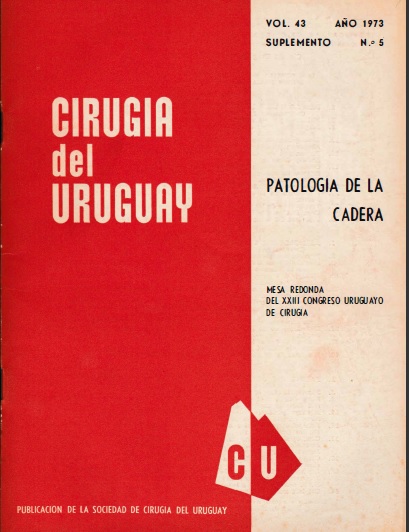Hidatidosis de la cadera
Palabras clave:
quiste hidático, caderaResumen
La localización de la enfermedad hidática en la cadera es particularmente grave. El período de latencia es muy prolongada y el diagnóstico no se hace en el
momento oportuno. Es una enfermedad de marcha progresiva, invasora y destructiva del tejido óseo. El hueso no se defiende, se deja destruir, es pasivo a la injuria parasitaria.
Las reacciones biológicas sirven de orientación y dan fundamento al diagnóstico. Radiológicamente las lesiones se exteriorizan por
zonas de destrucción ósea, imágenes !acunares o geódicas o "hueso apolillado','. Este proceso de osteosis geódica es de extensión variable, sin límites precisos
porque. no existe osteogénesis reacciona! limitante. La forma del hueso en general está conservada. En casos de excepción el hueso puede estar "soplado".
La osteosis geódica bipolar con indemnidad articular puede comprobarse así como la osteoartritis hidática en formas evolucionadas. Se analizan 11 casos, 8 corresponden a hombres y
3 a mujeres. Las lesiones tienen características de malignidad local y exigen un tratamiento precoz y radical. El tratamiento tiene doble fundamento: biológico y quirúrgico. El uso de la solución saturada de cloruro de sodio al 33 % propuesto por Velarde Pérez se ha generalizado complementando el acto quirúrgico. Cuando la localización es femoral, cervicoepifisaria
la operación de. Girlsdestone permite realizar la resección total de la lesión. Si la topografía es en el sector pelviano, comprometiendo el cotilo, se realizará la hemipelvectomía, con resección parcial del sector ilioisquiopúbico, con conservación o no del miembro, según la técnica descrita por el Dr. Guglielmone.
Descargas
Métricas
Descargas
Publicado
Cómo citar
Número
Sección
Licencia
Los autores conservan sus derechos de autor y ceden a la revista el derecho de primera publicación de su obra, el cuál estará simultaneamente sujeto a la licencia Creative Commons Reconocimiento 4.0 Internacional License. que permite compartir la obra siempre que se indique la publicación inicial en esta revista.


























